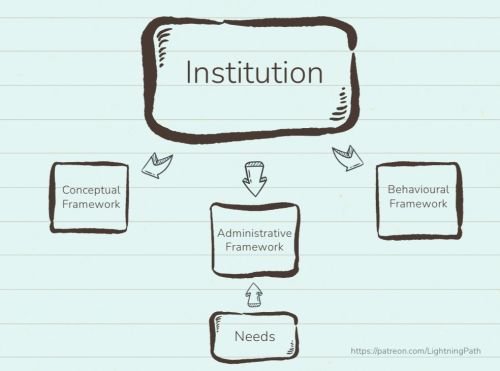Difference between revisions of "Conceptual Framework"
(Created page with "<blockquote class="definition"> A '''Conceptual Framework''' is the complete set of concepts and ideas that define the nature, scope, and purpose of an Institution. An in...") |
|||
| (One intermediate revision by the same user not shown) | |||
| Line 1: | Line 1: | ||
<blockquote class="definition"> | <blockquote class="definition"> | ||
A '''Conceptual Framework''' is the complete set of concepts and ideas that define the nature, scope, and purpose of an [[Institution]]. | A '''Conceptual Framework''' is the complete set of concepts and ideas that define the nature, scope, and purpose of an [[Institution]]. | ||
An institution's conceptual framework is one of three components of an [[Institutional Framework]], the others being the [[Administrative Framework]], and [[Behavioural Framework]]. | An institution's conceptual framework is one of three components of an [[Institutional Framework]], the others being the [[Administrative Framework]], and [[Behavioural Framework]]. Note, the conceptual framework of an institution may be overt and "on the surface" ([[Surface Framework]] or covert and hidden from view ([[Hidden Framework]])) | ||
</blockquote> | </blockquote> | ||
| Line 7: | Line 7: | ||
==Types== | ==Types== | ||
[[ | [[Conceptual Framework]] > {{#ask:[[Is a::Conceptual Framework Type]]}} | ||
==The Three Institutional Frameworks== | ==The Three Institutional Frameworks== | ||
| Line 24: | Line 24: | ||
<center>[[image:institution.jpg|500px]]</center> | <center>[[image:institution.jpg|500px]]</center> | ||
Because society's current set of institutions primarily services the needs of the [[Accumulating Class]], most institutions have both a surface framework (the ideas and justifications taught to the masses) and a [[Hidden Framework]], something typically not spoken of explicitly, at least to the general public. A teacher for example will teach that schools are there to create educated, hard-working, democracy-loving young adults. Teachers will not tell you (perhaps because they themselves do not understand, or perhaps because they have been led to believe in the moral rectitude of the current educational system) that schools also teach a [[Hidden Curriculum]]<ref>Anyon, Jean. “Social Class and the Hidden Curriculum of Work.” ''Journal of Education'' 162, no. 1 (1980). https://www.jstor.org/stable/42741976.</ref> designed to create a compliant and subservient working class. | Because society's current set of institutions primarily services the needs of the [[Accumulating Class]], most institutions have both a surface framework (the ideas and justifications taught to the masses) and a [[Hidden Framework]], something typically not spoken of explicitly, at least to the general public. A teacher for example will teach that schools are there to create educated, hard-working, democracy-loving young adults. Teachers will not tell you (perhaps because they themselves do not understand, or perhaps because they have been led to believe in the moral rectitude of the current educational system) that schools also teach a [[Hidden Curriculum]]<ref>Anyon, Jean. “Social Class and the Hidden Curriculum of Work.” ''Journal of Education'' 162, no. 1 (1980). https://www.jstor.org/stable/42741976.</ref> designed to create a compliant and subservient working class. | ||
Latest revision as of 14:12, 15 October 2024
A Conceptual Framework is the complete set of concepts and ideas that define the nature, scope, and purpose of an Institution. An institution's conceptual framework is one of three components of an Institutional Framework, the others being the Administrative Framework, and Behavioural Framework. Note, the conceptual framework of an institution may be overt and "on the surface" (Surface Framework or covert and hidden from view (Hidden Framework))
Types
Conceptual Framework > Hidden Framework, Surface Framework
The Three Institutional Frameworks
Institution > Conceptual Framework
Related LP Terms
Conceptual Framework > Creation Template
Non-LP Related Terms
Notes

Because society's current set of institutions primarily services the needs of the Accumulating Class, most institutions have both a surface framework (the ideas and justifications taught to the masses) and a Hidden Framework, something typically not spoken of explicitly, at least to the general public. A teacher for example will teach that schools are there to create educated, hard-working, democracy-loving young adults. Teachers will not tell you (perhaps because they themselves do not understand, or perhaps because they have been led to believe in the moral rectitude of the current educational system) that schools also teach a Hidden Curriculum[1] designed to create a compliant and subservient working class.
Footnotes
- ↑ Anyon, Jean. “Social Class and the Hidden Curriculum of Work.” Journal of Education 162, no. 1 (1980). https://www.jstor.org/stable/42741976.